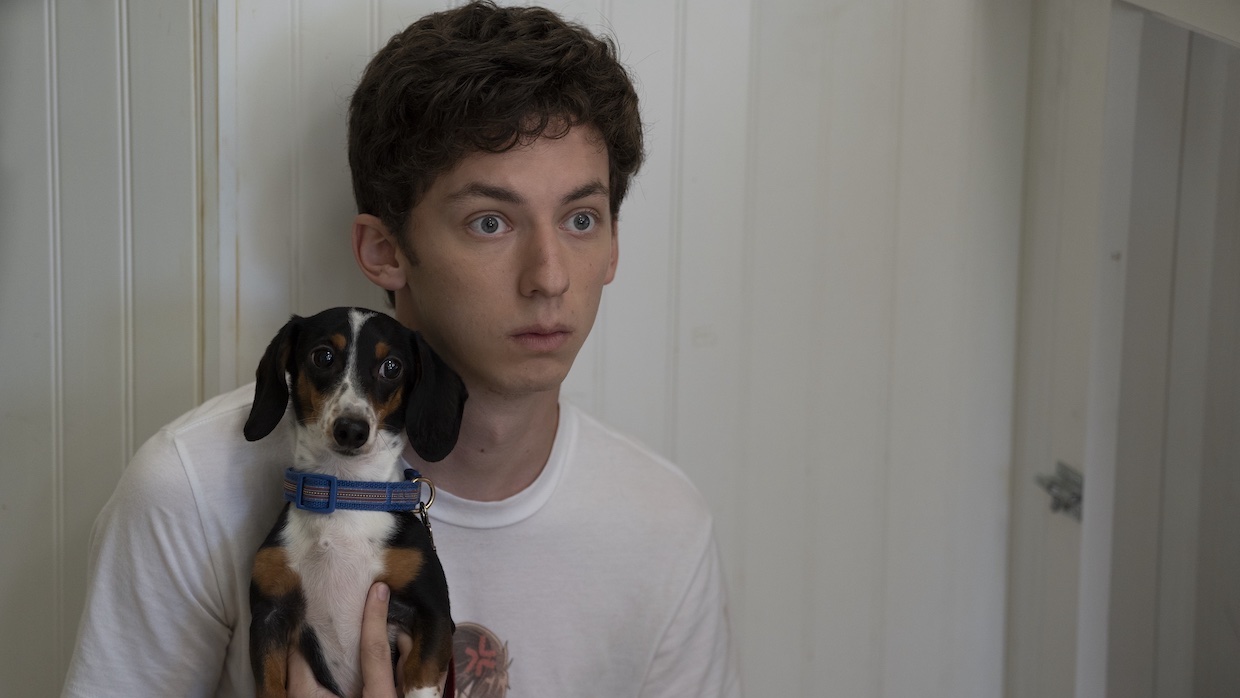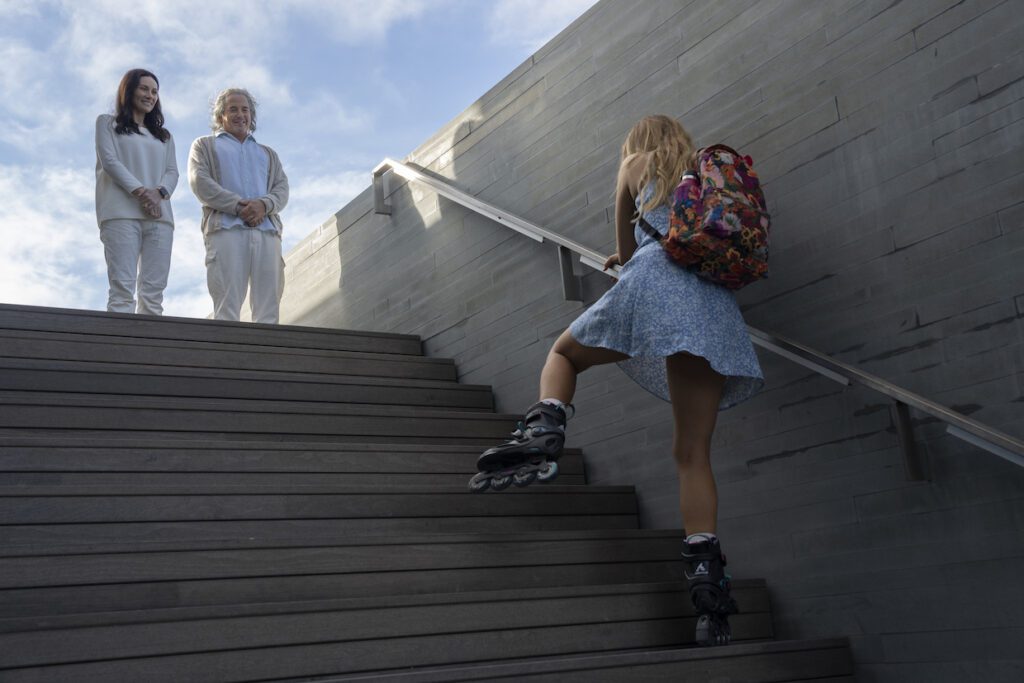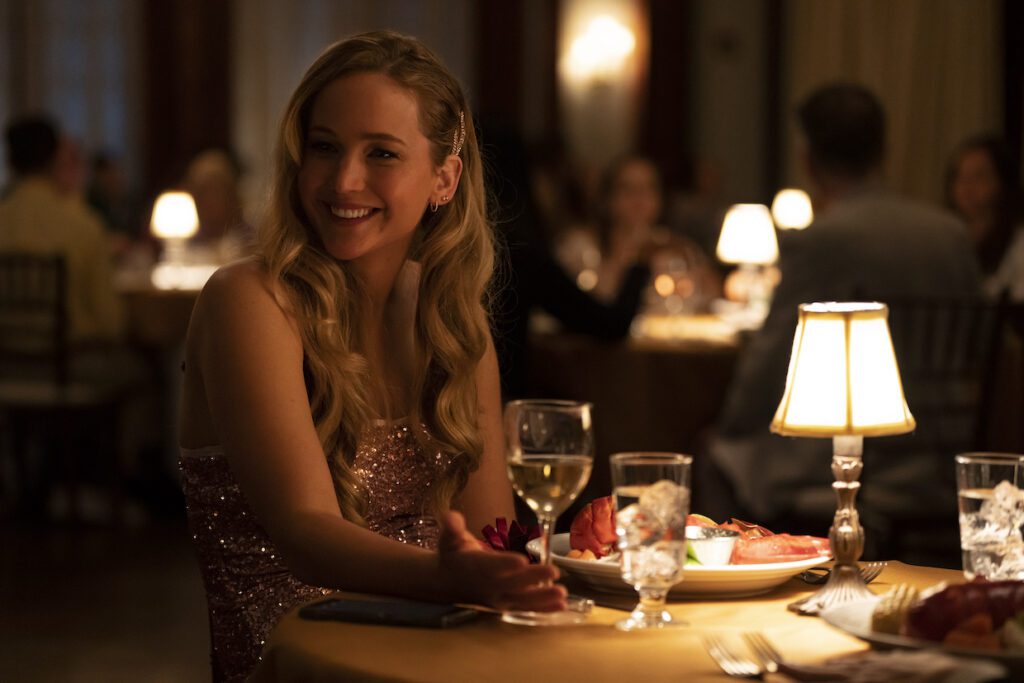 Back to selection
Back to selection
Shutter Angles
Conversations with DPs, directors and below-the-line crew by Matt Mulcahey
“It’s Never Fun to Do Nude Work”: DP Eigil Bryld on No Hard Feelings
 Andrew Barth Feldman in No Hard Feelings
Andrew Barth Feldman in No Hard Feelings Eigil Bryld must be feeling funny lately. After a career peppered with reality-based dramas (You Don’t Know Jack and The Report), thrillers (Deep Water) and romantic period pieces (Tulip Fever and Becoming Jane), the Danish cinematographer has lightened up with a trio of comedies out this year—The Machine, Alexander Payne’s The Holdovers and No Hard Feelings.
In the latter, Jennifer Lawrence plays a Montauk Uber driver who agrees to seduce the son (Andrew Barth Feldman) of a wealthy couple summering in the quaint Long Island enclave in exchange for a used Buick Regal. Bryld spoke to Filmmaker about lensing the ever-rare R-rated studio comedy, including trying out Arri’s Alexa 35 and continuing his newly adopted adventurousness in selecting glass.
Filmmaker: How much of the film was actually shot in Montauk?
Bryld: We only had one week in Montauk and the rest was shot all around Long Island and on stages. We wanted to get some of the daytime beaches on Montauk and some of the town’s landmarks. If we had the money, it would have been better to shoot much more there.
Filmmaker: Did you build interior sets for the hero houses of Maddie (Lawrence) and Percy (Feldman)?
Bryld: We built Maddie’s house interiors, and we built Percy’s bedroom. We actually used two different houses for [Percy’s] parents’ house, and the same family owned both—one in Montauk with more of hilltop view, which was required by the story, but the same architect also built a similar house in Long Island for the same family. That’s where we did all the interiors [except for Percy’s bedroom]. The exterior of Maddie’s house was also shot in Long Island, a location we really struggled to find because it had really specific requirements. It had to be a fairly big plot of land so that it would seem desirable for the developers [trying to buy the property from Maddie], but the house had to be small and cute as well. We’d actually picked another house that fell through the Friday before we started shooting that location. The house we had originally picked was facing north, so it would always be backlit when we were looking at the house, but the one we had to shoot in was facing east, which was full-on a lighting continuity nightmare. It’s a summer film, but we got started way too late. I think we started shooting in September, so the days were shorter. With turnaround issues and traffic in Long Island, it was difficult in terms of having enough daylight.
Filmmaker: There’s a separation between the locals who live in Montauk year-round and the more affluent people who just summer there. In keeping with that, Percy’s house is very antiseptic, while Maddie’s feels a little more homey.
Bryld: Maddie inherited the house from her mom, so we wanted something more weathered and textured that showed her personality and her charm, with the light emitted from inside the frame by practicals. In contrast, Percy’s place is supposed to be like one huge fish tank. It’s not a space that’s meant to feel cozy and warm. It’s much more about functionality.
Filmmaker: I was trying to think back to the last R-rated studio comedy that I really enjoyed before this and Game Night was my first thought, which is now five years old. It’s not a genre that’s been done a lot lately. You haven’t shot a ton of comedies—In Bruges is often very funny, but I wouldn’t necessarily classify it as a comedy. What was the attraction for you to this genre that has been neglected lately?
Bryld: Reading the script made me curious, then I spoke to [director] Gene Stupnitsky. I liked his sensibility because even though the movie obviously is a comedy, the intention was very much to treat it as a drama disguised as a sex comedy. It was really about Maddie’s journey. She’s stuck in life and the movie is about her letting go of the past and moving on. Similarly, Percy is maybe not stuck in life, but he’s locked in a cage. One of the main references was The Graduate, which is a funny movie but considered a drama more than a comedy, certainly. We wanted to be quite specific about where we put the camera, though most of the time we did two cameras just to nail every little moment and let the actors run with it a little bit. It was all happening very fast. The movie was supposed to shoot a year later, but all of a sudden it got pulled up because there was a window in Jennifer’s calendar. There wasn’t a lot of improvisation, but we did have John Phillips, the script writer, on set to write jokes for the moment. There was a lot of what we called “candy bag,” where at the end you do alternate lines just to create options in the cutting room. The coverage had to be mindful of that extra layer that you wouldn’t normally do in a straight-up drama, but our goal was to not be overly broad in terms of coverage.

Filmmaker: But you do have to frame sometimes specifically for the joke, like the wide shot where Lawrence is struggling to climb up the stairs in roller blades to get up to Percy’s parents or the tilt-down reveal that Percy has worn a suit jacket and shorts to their first date.
Bryld: There is a fair amount of physical comedy in the movie and both Jennifer and Andrew were really good at that. Traditionally with a lot of verbal comedy you live in a close-up and protect that close-up so you can cut freely and compress time and really get the timing right. We wanted to prioritize wider shots rather than just living in closeups and mid-shots.
Filmmaker: You used the Alexa 35 with Arri Moviecam lenses on the film. You’re the first person I’ve interviewed who shot on that new 4K Super 35-sized Arri camera. Tell me about your experience with it.
Bryld: I had to fight quite a bit to get it because it was so early in that camera’s production pipeline. We were going to need two cameras, then a third body as a backup, because we planned on a fair amount of Steadicam, which didn’t end up happening. Since it’s a Sony movie, I’m sure if the Alexa 35 hadn’t been available there would have been a lot of strong-arming to go with the Sony Venice, which I’ve used in the past and it’s not a bad camera at all. But since digital took over I’ve pretty much exclusively shot on Alexas, except for House of Cards, which was Red, and I did another TV show where I used a Sony. I also wanted to shoot with a Super 35 [sized chip] on No Hard Feelings. I’ve shot the larger and intermediate formats as well and they certainly have their time and place, but there’s something about the way Super 35 renders space that just seems more classical. I sometimes have the feeling you’re a little bit lost in a void on the large chip formats. When I did [the Adrian Lyne thriller] Deep Water we tested a lot of that and ultimately I found that it lacked the same sort of intimacy as Super 35 and intimacy was obviously really important in No Hard Feelings. The extended latitude of the Alexa 35 is also a great help because it does have more stops in the highlights. I know you can do all the textures and all that with the camera, but I didn’t go into all of that.
Filmmaker: Did you test any of the new textures? They are essentially burned into the footage, right? So, you’re pretty much married to that grain or that texture, as opposed to adding it in post and having more control over it.
Bryld: I did another project recently with Alexander Payne [The Holdovers] that was set in the 1970s, but not only is it set in that era, we tried to shoot it in a way so that it actually looked like it was made in the 1970s. So, I’d done a lot of experimenting with grain, and we did actually end up adding a little bit of a grain on No Hard Feelings, but much to your point I wasn’t interested in testing the textures [of the Alexa 35] just because it seems crazy to me to bake it in. If you decide you want to have a different texture, do you have to unbake it? Or if you decide you want to have more grain later, do you then add grain on grain or do you have to degrain it and then add grain again? So, I didn’t test it.
Filmmaker: I wasn’t familiar with those Moviecam lenses. So, they took the 1970s and 1980s glass from the original Moviecam sets and rehoused them?
Bryld: I had never heard about them before either. I was at Arri and they started talking about those lenses and I thought they sounded cool. I remember Moviecam from back in the film days. So, I tested them and they’re not super full of odd characteristics. They’re fairly even. I tested them against Arri Master Primes and also some more vintage glass. They did have a little bit of a fall-off that had a nostalgic feeling, and, in terms of the colors, seemed like they would help us in getting a little bit more of a beachy sort of palette. They’re fairly clean in terms of distortion and aberrations, but at the same time it is older glass, so it’s not too contrasty and it’s pleasant on the skin. We played around with them for a week or so and it just seemed that they were right for the project. In the past I used to be conservative with the lenses. I pretty much always shot Master Primes or even anamorphic Master Primes. I like the idea of controlling the softness and contrast in front of the camera as opposed to with the glass, but I have gotten away from that in recent years and I’ve been more open to different lenses. There are so many options nowadays. I used to drive Panavision mad because I would get Panavision equipment and make them rent Arri Master Primes, which they were not always too happy about. (laughs)
Filmmaker: Tell me about that skinny dipping scene at night, which turns into a nude beach brawl.
Bryld: The first beach part of the scene was shot on a real beach on Long Island, but for the water work —it sounds crazy looking back at it, but we had to fight so hard to get the permission to spend the money on building a tank rather than shooting in the ocean in October in the middle of the night with whatever weather there was. I mean, if one thing touches Jennifer’s legs in that water she’s going to get out of there and never want to go back. So, everything in the water ended up being done in a tank. Then for the fight, they initially wanted us to do that on a real beach as well. She was going to be full-on naked—she had a “mankini” or whatever they call it to cover some things—but if we had done that on a real beach there’s no way we could control things like the paparazzi in this big open, exposed place. So, we ended up shooting plates and then basically doing a big sandbox on a stage. We shot it very late in the schedule. Credit to Jen. It’s never fun to do nude work, because I find that there’s so much tension and you just want to do it fast and be mindful [of the actor’s comfort]. So, we shot that pretty efficiently.

Filmmaker: My favorite scene in the movie is when Percy plays Hall and Oates’ “Maneater” for Maddie on the piano at an upscale restaurant. There’s a great push-in on Lawrence where you see her expression change as she watches him perform. She’s so good in that moment.
Bryld: That scene actually came into the script after they cast Andrew, because they realized he’s really good at playing the piano. Before that moment it has been all about the car for Maddie and now she’s actually realizing that he’s not just some kid who’s being manipulated by his parents. He actually has real talent and a real tenderness. We talked about that moment as a turning point, where she begins to think, “What have I gotten myself into and what have I gotten this kid into?” We did two matching shots. We dollied in on her to almost enlarge that moment and see every little nuance as her expression changes. Then we did the same push-in on his side as well, which shows him physically expanding in the frame as he grows on her. It’s probably the most genuinely emotional scene of the movie that doesn’t also have any comedy in it.
Filmmaker: When the movie came out, one of the things that a lot of the writing around it highlighted was that Jennifer Lawrence is one of the last real movie stars. When you light a close-up of someone in that rarified position, how do you approach it?
Bryld: First, Jen is fantastic to work with. She doesn’t play any sort of diva. She does sometime have an issue with having too much light in her eyes because she tears up. So, sometimes she would actually ask to have negative put around, which isn’t typical. For this film, obviously, I was lighting for beauty, but at the same time her age is part of the drama of the film. So, if I lit her to look 19 that would take away from the whole premise of the movie. Her and Andrew’s faces are very different, and they both take different kinds of light differently, so it’s just about designing shots and blocking them in way that’s favorable to the actors.
Filmmaker: Let’s finish up with the scene where Maddie is driving with Percy on the hood of her car while the police are chasing them toward a railroad crossing with an oncoming train.
Bryld: That was super complicated. Most of the interior work was done at Joe White’s car stage. We had second unit do all the plates beforehand and had it all storyboarded. We went back and forth quite a lot about how much of an action comedy feel we wanted, because for a long time we had planned for a more ambitious, stunty approach. There was going to be a gate crossing that came down that they were going to crash through. Then we realized that seemed too dangerous [for the characters] and it took us out of the scene. The police light effect is very easy nowadays because you can just get SkyPanels for that. For the train lights, we just did that with two flags that we opened up [as the train is supposed to be getting closer] to increase the intensity. The train is all VFX and Brainstorm Digital did a good job with that. That sequence was just about careful planning then leaving it to the cutting room to tell you if you got it right or not.
